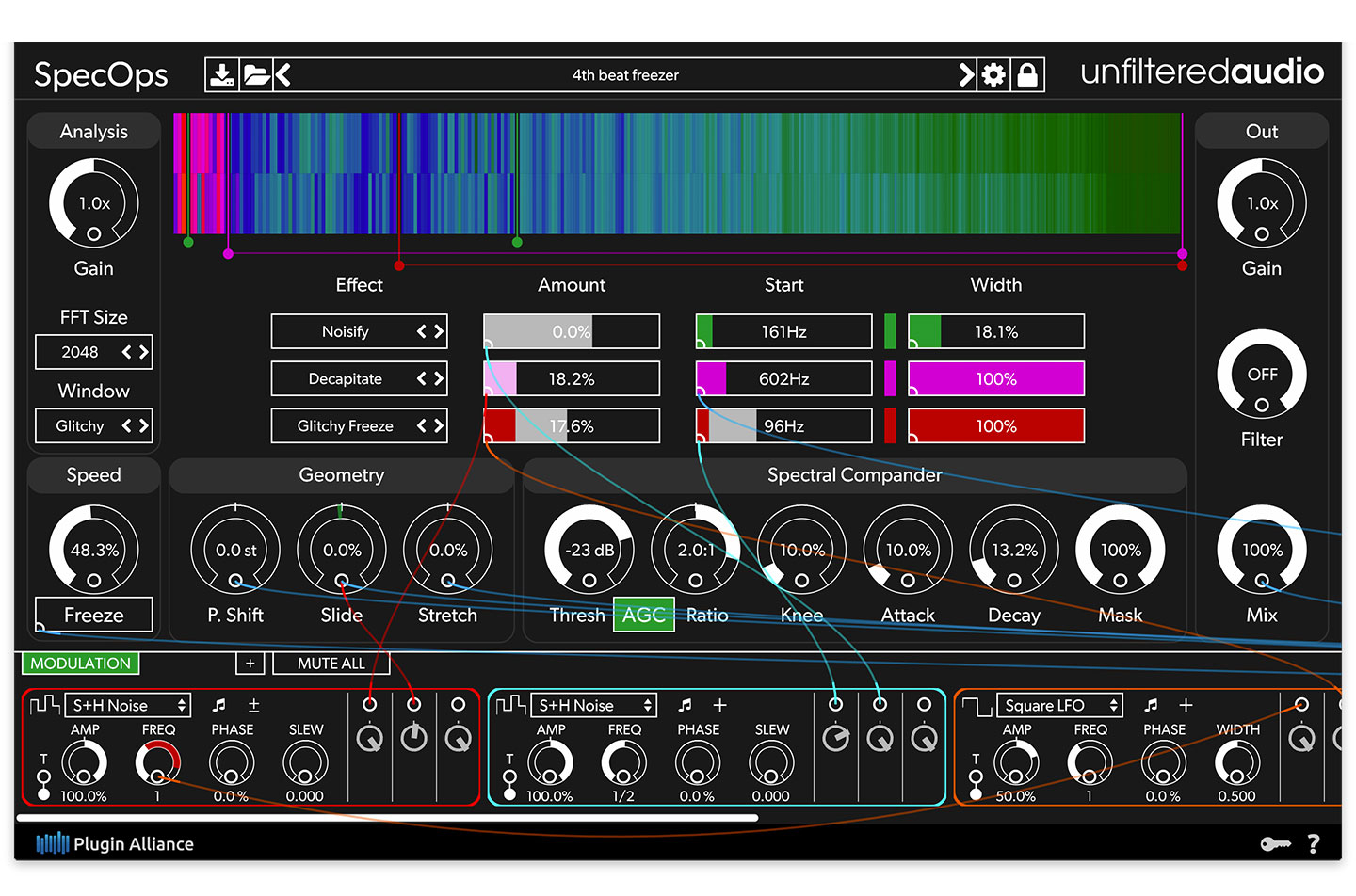- In the audio world, spectral processing describes the analysis of a chunk of audio in order to identify the individual frequencies contained within it. For instance, analysing a single sine wave would result in the identification of a single fundamental frequency. Nearly every audio plug-in does this in some fashion using an algorithm known as the fast Fourier transform (FFT), but usually its role is limited to serving as a vehicle for accomplishing a typical analogue-modeling audio effect. In some rare cases, however, the FFT algorithm itself is unleashed as the basis of a creative effect. The most recent example of this comes from Unfiltered Audio: a creative spectral processing plug-in called SpecOps.
The SpecOps manual begins by describing the ways the developers attempted to reign in CPU utilisation and notes on expectations regarding spectral artefacts and ways to handle them—the first clues that this is no simple plug-in. Further confirmation arrives with the plug-in's UI, which includes controls with labels like FFT Size, Geometry and Spectral Compander. Only engineers and serious audio geeks would be able to intuit these concepts without consulting the documentation. Thankfully, the SpecOps UI provides helpful tips that reinforce the concepts without having to make return trips to the manual.
The signal flow in SpecOps generally travels left-to-right across the UI. Everything starts in the analysis section, which gives you control over the way the aforementioned chunks of audio (referred to as "windows" in FFT parlance) are processed. This includes both window size, which has a direct correlation to the resolution of the frequency analysis, and window type, a mysterious control that is not explicitly detailed in the manual. This ambiguity is the first of many indications that experimentation is built into the design of SpecOps. The best way to get an idea of the effect that the window type choices have on incoming audio is simply to try them out.
From the analysis module, the audio moves into the Speed and Geometry sections, which house the core of SpecOps' creative application of the FFT algorithm. The Speed control uses feedback between the frequency analysis frames to smear incoming audio and make it sound slower. Taking this control down to 0% loops the current audio chunk, transforming SpecOps into a sort of resampling granular synthesiser. When you combine this with the pitch shift control in the Geometry section, which shifts audio in semitone amounts, SpecOps can be used as a playable instrument. Anticipating this, the Unfiltered Audio team added a freeze button, which lets you toggle the speed to 0% as a performance control. The Geometry section also houses two other controls which, like Pitch Shift, let you shift the frequency in experimental and inharmonic ways.
Even with just what's been described so far, the amount of power SpecOps gives you to twist and transform audio is undoubtedly impressive. But we haven't even gotten to the meat of the plug-in: the three effect slots. These are placed after the Geometry section in the signal flow and provide a selection of 36 different spectral effects, which can be applied at adjustable frequency bands. The list of effects spans the gamut of traditional filters and mixing tools to variations on the freeze effect as well as wild effects that act on the individual frequency elements. The more experimental effect types have names that make an admirable attempt to describe their function, but here again the tool tips are invaluable in describing what you're getting into. My only complaint with SpecOps' effects is with the UI elements that let you set the frequency range for each effect. The sliders make it very difficult to zero in on small ranges due to the way they work with percentages. It would be nice to be able to also use the bars on the UI's frequency display for these adjustments as well.
A good modulation system can add to an effect plug-in's versatility by orders of magnitude, and this is one area where Unfiltered Audio excels. Rather than reinvent a custom scheme for each product, they instead reuse a sophisticated modulation framework. This consists of a semi-modular style system that allows you to choose from six different modulator types and draw virtual patch cables to nearly every possible control on the SpecOps UI (the only things you can't control are the FFT window parameters and the effect types). The selection of modulators includes LFOs (sine, saw/triangle and square), an Input Follower, a Macro Control, a Step Sequencer, Sample and Hold and integration for the ROLI Lightpad. The controls on these modulators have mod inputs as well, allowing for more complex setups.
When you consider all of the flexibility and effect choices combined with the exploratory nature inherent to SpecOps, the sweet spot for this plug-in seems to be in experimental and sound design use cases. That's not to say that it can't be used for utilitarian mixing and effect purposes—Unfiltered Audio's own promo video seems to lean in this direction—but to me, it's not a plug-in that I would have running 100% wet on any channel, and certainly not on the master bus. But If you're looking for something to add a layer of chaos or creative inspiration to a track, this is one of the best options to hit the market in a long time.
Ratings:
Cost: 4.7
Versatility: 4.6
Ease of use: 4.1
Sound: 4.1
